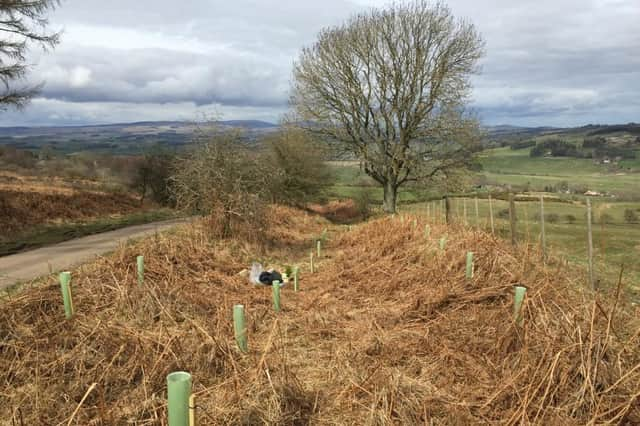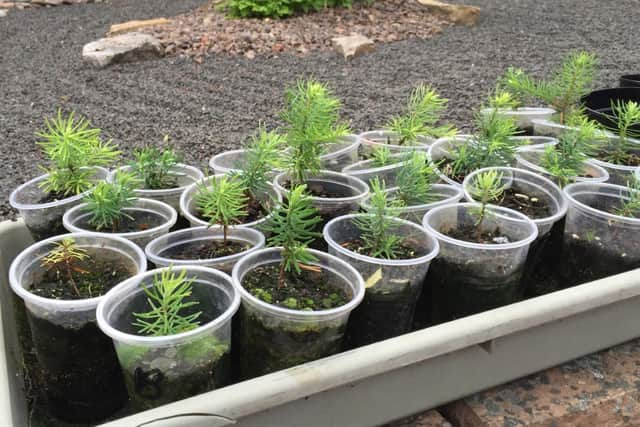The battle against climate change is taking root in Coquetdale


In Northumberland, we are extremely fortunate to live in a beautiful county with many trees; and have a council which has declared a Climate Emergency, and so is committed to dramatically reduce carbon emissions.
Do you know how much carbon can be locked up by woodlands? A stunning 400+ tonnes of carbon per hectare of young woodland with mixed native tree species.
Advertisement
Hide AdAdvertisement
Hide AdThis occurs in the living wood, in the roots, leaves, and even the deadwood, the surrounding soils and the associated vegetation.


Alan Winlow MBE is the vice-chairman of Whitton and Tosson Parish Council, a small parish in north Northumberland. I wrote about Alan in October last year: https://www.northumberlandgazette.co.uk/whats-on/arts-and-entertainment/alan-winlows-philosophy-exemplifies-his-creativity-life-and-his-thinking-639572. He was honoured with an MBE for his environmental and community work in 2000.
Since he returned to the county in 2005, Alan has been planting willow and trees in Northumberland.
He helps neighbouring farmers and landowners by planting shelter belts, avenues and hedging.
Advertisement
Hide AdAdvertisement
Hide AdDid you know that willow, as well as trees, play a key role in trapping carbon?
Growing and making products with willow, is another way to help in the climate emergency.
Alan is part of the Northumbria Basketry Group (http://www.northumbriabasketrygroup.co.uk), which promotes and enables the study and practice of all aspects of basketmaking in the Northumbria region.
How the tree planting project began
On a very stormy day in the autumn of 2018, a large ash tree on a local road blew down.
Advertisement
Hide AdAdvertisement
Hide AdThe fallen tree caused a lot of damage and Alan decided to replant the hedges where the tree had fallen.
He also planted five Norway maples to replace the fallen ash.
Reporting back to the parish council, the members all agreed that hedge and tree planting was something they should be doing more of.
Alan began to take note of areas of derelict land and places where the road verges are very wide, so might be suitable for tree planting.
Advertisement
Hide AdAdvertisement
Hide AdHe identified potential spaces, subject to certain criteria, such as whether the verge was wide enough to accommodate the trees, distance from overhead lines and so on.
As part of his parish council work, Alan submits reports regularly about the highways and footpaths within the parish to Graham Bucknall, Northern Area Highways manager at Northumberland County Council.
The two men toured the area to look at the sites which Alan had proposed. Graham gave the go-ahead to this project and has been very supportive of the initiative.
Alan has been helped and supported by a team of volunteers, notably Jane Cheadle.
Advertisement
Hide AdAdvertisement
Hide AdJane and Alan have been out in all weathers and conditions, checking on newly planted trees, weeding and planting. They are to be congratulated for having planted hundreds of trees so far.
Benches or trees?
Dedicating a bench to a loved one who is no longer with us, is a lovely idea. There are many dotted around in Coquetdale, with fine views that the deceased person once loved.
However, after some discussion and thought, Alan is suggesting that it might be timely to think instead about donating to plant trees in memory of loved ones.
By donating towards the purchasing of trees, residents can be sure they are helping to minimise the impact of climate change for future generations – as much as in memory of those who have gone before us.
Advertisement
Hide AdAdvertisement
Hide AdJane was very happy to purchase and plant a group of birch trees to commemorate family members who have passed away (Jane’s maiden name being Birkett, which means birch).
Where do they get the saplings?
The trees Alan and the volunteers are planting are grown from seed.
They are grown by many people who are helping with the project. And many people generously donate tree seedlings which they have carefully nurtured.
The team also transplant seedlings from where they have self-seeded in a less advantageous place to a more beneficial location.
Advertisement
Hide AdAdvertisement
Hide AdCell grown trees are also purchased from http://www.cheviot-trees.co.uk/. This company has been extremely helpful in supplying a variety of appropriate trees for our local areas.
They are not expensive, costing around 40-50p each. The expense comes with the need for tree shelter accessories.
Fortunately, kind residents have donated copious amounts of these which has helped enormously with the costs of the project.
Helping Mother Nature
It is a great delight when nature decides to plant her own trees, of course. Recently, when Alan and Jane were clearing weeds from around recently planted grand firs, near a noble fir, on Simonside, they found 33 tiny noble fir seedlings growing in the bare earth.
Advertisement
Hide AdAdvertisement
Hide AdThis can happen when the seeds take root on disturbed ground. Presumably, the cultivation of the earth in the areas around the newly planted trees has promoted this hopeful new growth.
Of course, this would not have happened if they had not planted the grand firs in the first place. Jane and Alan have collected all these precious seedlings and potted them up for future planting.
For advice on planting trees in your area, contact [email protected] or log on to www.northumberland.gov.uk/climatechange